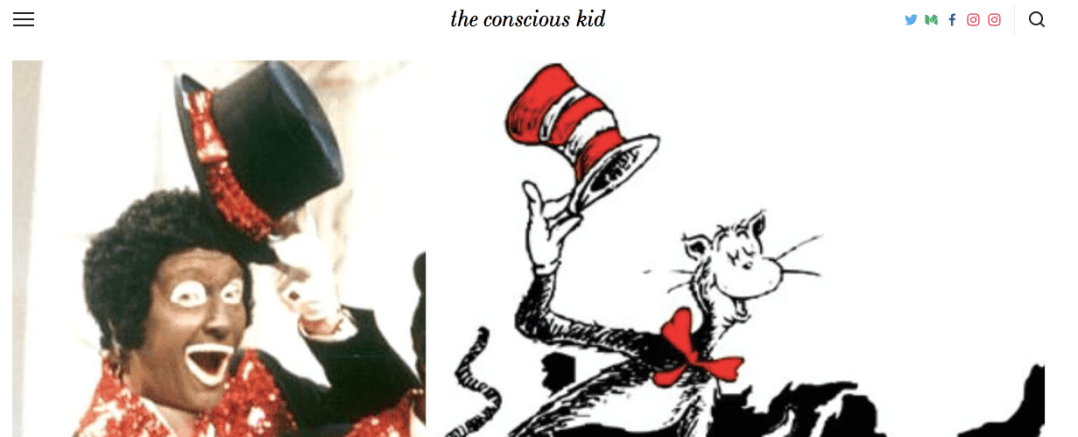About a year ago, The Conscious Kid published an article titled, “A Critical Race Reading of Dr. Seuss and Resource Guide for Read Across America Day 2018”. The article was about the explicit racism that Dr. Seuss engaged in, including wearing blackface, participating in minstrel shows, depicting characters of color in racist ways, and creating anti-BIPOC (Black, Indigenous, People of Color) artwork and writing. It also analyzed the racism within some of his famous characters and books with the support of recent published research.

Recently, this article has attracted a large amount of attention from social media and media outlets because a couple weeks ago was Read Across America Week and the journal Research in Diversity of Youth Literature published an article titled, “The Cat is Out of the Bag: Orientalism, AntiBlackness, and White Supremacy in Dr. Seuss’s Children’s Books”.
Many people, especially people of color (including myself), were relieved to finally see this uncovering of racism attract more national attention. I did not learn about the racism of Dr. Seuss until 2018 when I saw his anti-Japanese cartoons and learned of his anti-Black behavior. Before I learned of it, I had read his books, helped my students make Cat-in-the-Hat crafts, and celebrated him. I feel bad that I exposed my students to a racist author with celebration and without doing a critical analysis of his work. However, as teachers, we always need to adapt and change our practices when we learn about new information.
Considering this, I stopped celebrating and reading Dr. Seuss, but I also explored alternatives to him and am trying to understand how to use his work to critically analyze racism with students (since we should not just ignore racism, but acknowledge and redress it). Throughout this work, I have heard several things that teachers will miss about Dr. Seuss or reasons why people wish they could still read/use it. To help everyone choose anti-racism over the “tradition” of using Dr. Seuss, I have composed three themes/reasons that people give for still using Dr. Seuss and amazing alternatives for them:
1. “What about the rhyming?”
2. “But I love the illustrations!”
3. “We’ve always celebrated Dr. Seuss!”
The rest of this article will briefly explore the themes/reasons and present the alternatives we can do instead. Now is the chance for us to choose anti-racism over “tradition”!

“What about the rhyming?” → Try These Rhyming Diverse Books!
In the Twitter verse, many people have been worried about how they are going to teach or expose their children to rhyming without Dr. Seuss. While I understand that Dr. Seuss has some crafty rhyming, there are MANY other books that feature rhyming that are not written by authors with a racist history.
There are especially some amazing diverse books that have great rhyming! So, swap out Cat in the Hat with one of these to not only support anti-racism, but support diverse books!! Here are a list of several great diverse books with rhyming:
- Round is a Mooncake: A Book of Shapes, by Roseanne Thong
- Red is a Dragon: A Book of Colors, by Roseanne Thong
- We Came to America, by Faith Ringgold
- Ada Twist, Scientist, by Andrea Beaty
- Under My Hijab, by Hena Khan
“But I love the illustrations!” → Check Out These Amazing Illustrators of Color!
Within my own school district, I have overheard many educators and families talking about how much they loved the illustrations in Dr. Seuss’s books. However, we need to acknowledge the racist themes within his illustrations. His iconic Cat-in-the-Hat illustration is based on “minstrel stereotypes” and his illustrations rarely depict a person of color (and most of his POC illustrations have harmful and prejudicial stereotypes attached to them).
Therefore, instead of celebrating these illustrations that could harm our students, educators, and communities of color, let’s replace them with some better illustrations! Help counteract the harm by showcasing positive and accurate depictions of diverse characters. And, who knows diverse characters better than diverse illustrators? Check out this list of some of my favorite illustrators of color:
“We’ve always celebrated Dr. Seuss!” → Teach About His Racism OR Ditch “Tradition”
With this article, I am not suggesting that we forget about Dr. Seuss, because, to forget Dr. Seuss is to not acknowledge the hurt that his illustrations and he have caused. However, we need to STOP celebrating him! I understand it is our “tradition” and he has been ingrained in many of our own childhood memories. BUT, we do not want our students, children, families, educators, and communities of color to endure more harm and racism for the sake of “tradition”.

Instead, let’s use Dr. Seuss’s books and racist history to teach our students about racism and the harm caused by stereotypical and false depictions. I wish that I could link a good lesson plan about how to guide your children and/or students through a racial analysis of his books and illustrations, but unfortunately I could not find one.
It is possible to teach this though! I have had many conversations with my first graders about racism. Our students live in a world with racism. Instead of censoring it and letting history repeat itself, we need to teach anti-racism and show our students how to debunk the racism that often lies within “tradition”.
—
I hope this helps educators, librarians, and families who are on the fence about choosing anti-racism over Dr. Seuss! Please pass this along to your colleagues so everyone can see that there are AMAZING alternatives to Dr. Seuss.







I am sorry….. but this is going way overboard. As a teacher with the K-4, I do not see children being so racist. It’s a learned behavior from home. When children are little all they are taught over and over in school is to love one another and be kind!!! Dr. Seuss is loved by the children please don’t take that enjoyment away…. some have so little anyway!
LikeLike
As a K-4 teacher you then understand that you are laying a foundation for thoughts, beliefs in how they navigate the world as they grow and mature. So embedding and exposing your students to a diverse and inclusive world is obvious they route I’m sure you are doing. No one is saying take it away, Don’t make it the only thing and also be a teacher that is conscious and responsive to your students’ cultures.
LikeLiked by 1 person
What you are saying is correct. There should be diverse examples provided to children. However, the article is in fact vilifying Dr. Suess.
LikeLike
I urge you to look at the research article from Conscious Kid that really delves into the racism within Dr. Seuss’s illustrations and depictions: https://sophia.stkate.edu/cgi/viewcontent.cgi?article=1050&context=rdyl. There are even several books his publisher took off the market due to the racism. His illustrations harm communities of color. There are MANY more books that are more beautiful and bring students more enjoyment that I have laid out in this post and our website.
LikeLiked by 1 person
Learned beahviour, exactly. Even unconscious bias helps to teach bias and racism. At one point in our history smoking cigarettes was deemed to be normal, cool and even desirable. We have learned of the personal harm that they cause as well as the cancer caused through second hand contact. Even though cigarette smoking still occurs, schools now play a role in educating students about their harm. If we know Dr. Seuss’ ideas, even within his books are racist, then we have a responsibility to act, or at least acknowledge the racism they contain and make conscious decisions in using these books. You may be part of the “privileged group” but likely many of your students in grades 1-4 are not. At the end of the day, no one is taking away the enjoyment of learning but rather helping to grow that learning in a different way.
LikeLike